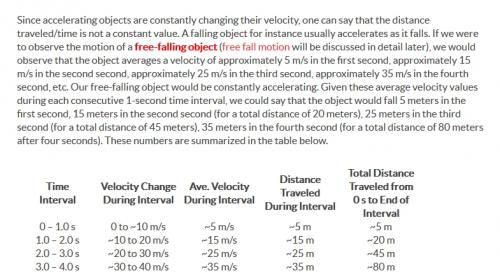-
Posts
6258 -
Joined
-
Last visited
-
Days Won
2
Content Type
Profiles
Forums
Events
Everything posted by michel123456
-
Right. What i say is that "expanding at an increasing rate" is a direct effect of scaling. The second derivative is inherent (or maybe I am wrong here, that was my question) Now, if the data show that something more is needed to coincide with the observation, then it is not about an acceleration of expansion anymore, it is about an increase of acceleration of expansion, a third derivative.
-
------------------- I didn't expect to be such a difficult question to answer. Let me put it in another way: From the wiki article it says that What I say is that a scale factor by itself introduces a distance continuously increasing with time. There is no need for an "increasing scale factor". Am I wrong?
-
Oh. I thought it was simply explained that the rate of separation is increasing. Where do you get your info from?
-
At the risk of derailing the thread... Scaling. Question: isn't scaling a kind of acceleration? For example, if you double a segment made up of numbers like this below 1-2-3-4-5-6-7-8-9 that becomes by doubling the intervals 1--2--3--4--5--6--7--8--9 The horizontal "distance" between the two 1 is null The "distance between the two 2 is - between the two 3 is -- Ans so forth, the distance between the two 9 is many -------- Like the effect of an acceleration. Is there a way of scaling that can avoid that?
-
Motion is one of the expressions of conservation of energy.
-

Real time objects and their significance
michel123456 replied to petrushka.googol's topic in Speculations
The design of a school bus makes evident to the eye that it is a "mild" mean of transportation and the design of a ferrari shows that it is a spotscar. One can understand the difference even if both are at rest. The "nervous disposition" is not especially in the way of driving, it is also in the appearance. Sometimes simply in the color (like the difference between a white or a red car of exactly the same model) Similarly, the design of a house shows that it is a residence, the design of a church shows that it is a place of worship, the design of a school is also evident, like that of a prison, a train station, etc. Or at least it should. When it is not evident, it gets weird and raise the question what building is this? -

Real time objects and their significance
michel123456 replied to petrushka.googol's topic in Speculations
All these objects are the product of the human mind. Even better, your examples are those of objects where humans go inside (contrarily with a cup of tea for example) So in a sense, they are extensions of the human body, and thus yes, they "mimic real life scenarios". They "are" real life scenarios. A house without humans inside is abandoned and will become a ruin very fast. The same goes for abandoned vehicles. You can even make the very profound remark that sometimes these objects are symmetric as seen from the outside, and not symmetric as seen in the inside, like the human body. -
I agree. usually, war consists into killing or damaging a lot of innocent people. And erasing isis will not erase the djihads.
-
"war" means a lot of things. More than bombing and shooting. It means less civil rights. It may mean martial law, death penalty in justice & death penalty at sight. One can be condamned for trahison and spying just like that. Even worse, one can be send to prison just like that, without judgment. War is a bad bad thing for the French people.
-
One of my preferred from Philippe Geluck
-
I am afraid the attacks were driven by antisemitism. From this article in French: The Bataclan is a regularly referred target [/size]http://www.lepoint.fr/societe/le-bataclan-une-cible-regulierement-visee-14-11-2015-1981544_23.php[/size]
-
Thank you. Yes the acceleration is continuous, see post 14 http://www.scienceforums.net/topic/91928-universe-contracting/?p=890460 The scenario is the following Start Time0 : A0 -----> A1 ---------> A2 ----------------> A3------------------------------> A4-------------------------------------------------> A5 Start Time1 : B1 -----> B2 ---------> B3 ----------------> B4------------------------------> B5 Start Time2 : C2 -----> C3 ---------> C4 ----------------> C5 At Time2, A2 observes B2 & C2 At Time5, A5 observes B5 & C5, the distance has increased. 1) In cosmology, the delay is function of distance, IOW the other galaxies did not "start" at another time, the delay is caused by SOL. AND the redshift is function of distance also. So indeed we observe less redshift for galaxies closer to each us. 2) that is your question from the beginning. I think for galaxies side by side, maybe the small diagram above will help. For galaxies ahead, what we observe behind is the same with what we observe in the front. The system is reversible. I mean, what A5 observes looking at B5 is the same with what B5 observes looking at A5. Except that the cosmologic delay restricts us to see only galaxies in the past. That is to say only galaxies behind us. That is not easy to put on a diagram, because on paper the delay in time results in a shift in space and make things blurry.
-
A delay between the start time. Object A starts with acceleration a. Object B starts with same acceleration a but 1 sec after. In the same direction. On a parallel path. --------------------------- The 1 sec delay will remain the same all along. But since the objects are accelerating, the 1 sec gap will correspond to an increased distance.
-
Your ununderstanding is above my understanding. If there is a delay, that means the 2 objects have a different velocity, which takes us back to the former example.
-
Maybe he was reading books? https://en.wikipedia.org/wiki/Inverse-square_law#History
-
OK. Answer 3. ----------------- Now The 2 objects falling parallel side by side will stay at the same distance to each other. But Do you agree that if the 2 accelerated objects have a delay, say 1 sec, they will observe each other going apart?
-
Take 2 objects. They start at the same instant in the same direction with velocities V1 & V2, where V1 is different from V2. Question Do the 2 objects 1. keep a standard distance bewteen each other? 2. get closer to each other? 3. go away from each other?
-
There is no need. Take random velocities in parallel motion. Take a same starting point in time. Don't you see that it is an expanding model? What maths do you need to show that? ----------- There is no need to CALCULATE the velocity, the fact that velocities are different is enough and sufficient.
-
At the risk of repeating myself: because a long time ago their velocity was less than ours today. Or because a long time ago their velocity was more than ours (in my paradigm that is not allowable) The only thing that could eventually happen is to find a galaxy that had a long time ago the exact same velocity that we have today. You must imagine the coincidence: the same velocity at the exact right time and spot. But this situation is not allowable either, because in my paradigm, all galaxies are in a state of same acceleration and same velocity for a particular instant in the history of the universe. And travelling on parallelpaths towards the same direction. Which means that all observable galaxies around us have less velocity than us, simply because their are ancient.
-
In case of free fall I don't know. It may not be proportional to the distance. It is proportional to the delay and that is sufficient to me. I am escaping from the free fall example at this point and jumping into cosmology where we know that the delay is linearly proportional to distance.
-
Lets go to the beginning again. You have 3 objects One has velocity V1, the other V2, the last V3 Where V1<V2<V3 They are aligned and heading into the same direction with the configuration V1-V2-V3 Do you agree that V2 will observe V1 and V3 going away?
-
Because the source of the light has a lower velocity than you do.
-
Relevant is that in cosmology time (the delay) is a function of distance. Suppose you have a galaxy "falling" side by side with you, in the same "present time", at the same acceleration, at the same velocity. Because the galaxy is far away, you do not observe it "in the present" but as it was in the past. The galaxy in ancient time had the same acceleration, but not the same velocity. IOW, wathever the direction, the galaxy will look like going away. Of course, the velocity that you will observe will not be the same as the velocity of another galaxy at the same delay and aligned with your motion. The velocity will be less. But because you don't know out of hand the distance to the galaxy, the result of the observation will remain consistent with any other galaxy getting away from you.
-
I say that the system is expanding. From here http://www.physicsclassroom.com/class/1DKin/Lesson-1/Acceleration ---------------------------------------------------------------------------------------------------- ---------------------------------------------------------------------------------------------------- Now look at the table above considering 2 objects falling at 1 sec interval. You are the first to fall and look behind you. Take the values from the right column in the table _after 1 sec you have traveled 5m, your friend behind you is still at point zero. The apparent average velocity is the difference between the velocities = 5m/s _after 2 sec you have traveled 20m, your friend 5m, difference equals 15m (that corresponds to your average velocity 15m/s). The apparent average velocity is 15-5=10m/s. _after 3 sec you have traveled 45m, your friend 20m, difference equals 25m (that corresponds to your average velocity 25m/s). The apparent velocity is 25-15=10m/s _after 4 sec you have traveled 80m, your friend 45m, difference equals 35m (that corresponds to your average velocity 35m/s). The apparent velocity is 35-25=10m/s My conclusions are _that the system is expanding because the difference in traveled distance increases. _that the apparent average velocity between you & your friend is constant. You are observing the one behind you going away from you at constant velocity. In this case 10m/s And _If you are observing another falling friend at 2 sec interval behind you, the apparent velocity will be larger. In this case 20m/s. It is obviously a function of time (the delay). Now you are asking me to prove that it is a function of distance. That would have been easier for me thirty years ago...
-
Right. I should have stated without friction. And considering the drops falling in parallel, not radially. The drops are in free fall accelerating towards the Earth surface


